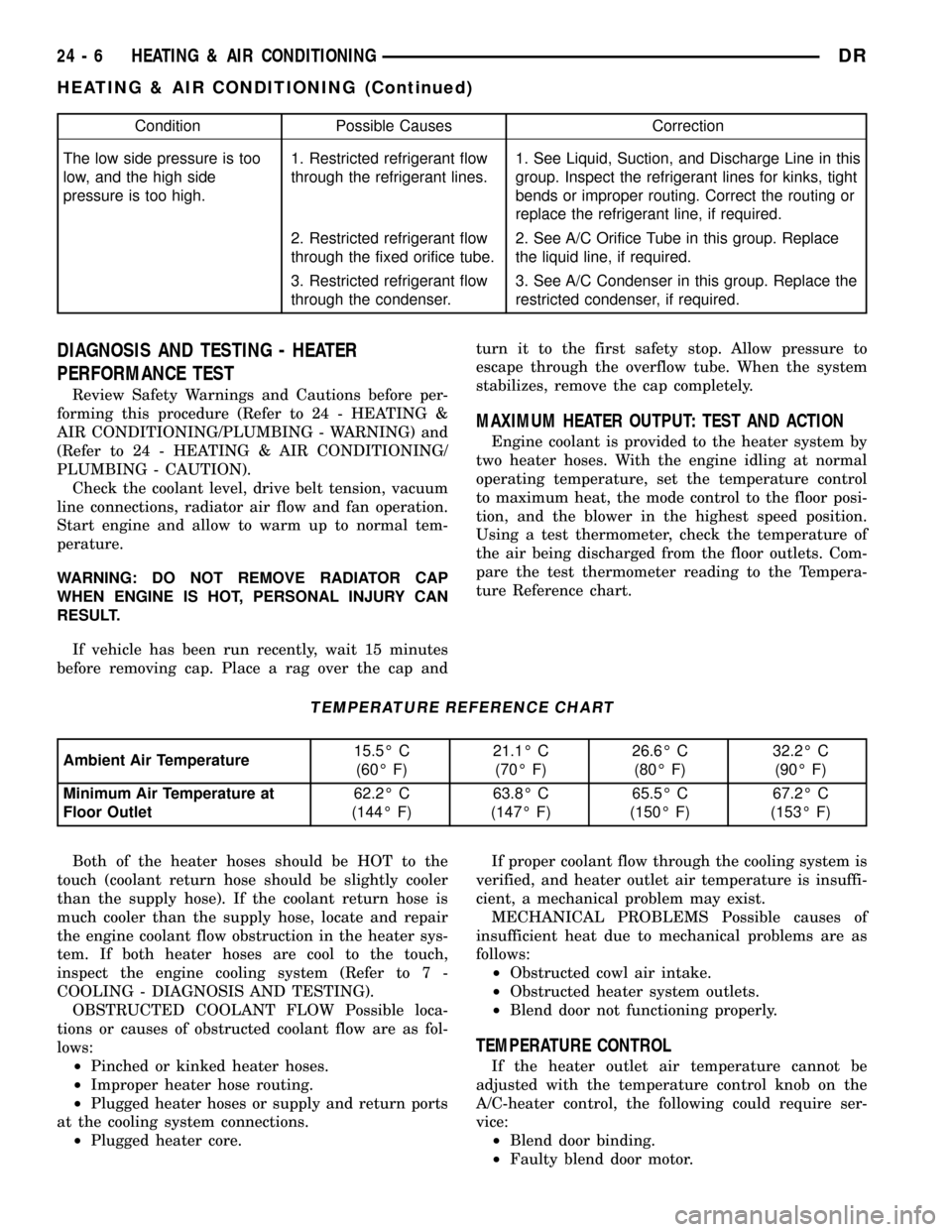1998 DODGE RAM 1500 heating %26 air conditioning
[x] Cancel search: heating %26 air conditioningPage 2493 of 2627

Condition Possible Causes Correction
The low side pressure is too
low, and the high side
pressure is too high.1. Restricted refrigerant flow
through the refrigerant lines.1. See Liquid, Suction, and Discharge Line in this
group. Inspect the refrigerant lines for kinks, tight
bends or improper routing. Correct the routing or
replace the refrigerant line, if required.
2. Restricted refrigerant flow
through the fixed orifice tube.2. See A/C Orifice Tube in this group. Replace
the liquid line, if required.
3. Restricted refrigerant flow
through the condenser.3. See A/C Condenser in this group. Replace the
restricted condenser, if required.
DIAGNOSIS AND TESTING - HEATER
PERFORMANCE TEST
Review Safety Warnings and Cautions before per-
forming this procedure (Refer to 24 - HEATING &
AIR CONDITIONING/PLUMBING - WARNING) and
(Refer to 24 - HEATING & AIR CONDITIONING/
PLUMBING - CAUTION).
Check the coolant level, drive belt tension, vacuum
line connections, radiator air flow and fan operation.
Start engine and allow to warm up to normal tem-
perature.
WARNING: DO NOT REMOVE RADIATOR CAP
WHEN ENGINE IS HOT, PERSONAL INJURY CAN
RESULT.
If vehicle has been run recently, wait 15 minutes
before removing cap. Place a rag over the cap andturn it to the first safety stop. Allow pressure to
escape through the overflow tube. When the system
stabilizes, remove the cap completely.
MAXIMUM HEATER OUTPUT: TEST AND ACTION
Engine coolant is provided to the heater system by
two heater hoses. With the engine idling at normal
operating temperature, set the temperature control
to maximum heat, the mode control to the floor posi-
tion, and the blower in the highest speed position.
Using a test thermometer, check the temperature of
the air being discharged from the floor outlets. Com-
pare the test thermometer reading to the Tempera-
ture Reference chart.
TEMPERATURE REFERENCE CHART
Ambient Air Temperature15.5É C
(60É F)21.1É C
(70É F)26.6É C
(80É F)32.2É C
(90É F)
Minimum Air Temperature at
Floor Outlet62.2É C
(144É F)63.8É C
(147É F)65.5É C
(150É F)67.2É C
(153É F)
Both of the heater hoses should be HOT to the
touch (coolant return hose should be slightly cooler
than the supply hose). If the coolant return hose is
much cooler than the supply hose, locate and repair
the engine coolant flow obstruction in the heater sys-
tem. If both heater hoses are cool to the touch,
inspect the engine cooling system (Refer to 7 -
COOLING - DIAGNOSIS AND TESTING).
OBSTRUCTED COOLANT FLOW Possible loca-
tions or causes of obstructed coolant flow are as fol-
lows:
²Pinched or kinked heater hoses.
²Improper heater hose routing.
²Plugged heater hoses or supply and return ports
at the cooling system connections.
²Plugged heater core.If proper coolant flow through the cooling system is
verified, and heater outlet air temperature is insuffi-
cient, a mechanical problem may exist.
MECHANICAL PROBLEMS Possible causes of
insufficient heat due to mechanical problems are as
follows:
²Obstructed cowl air intake.
²Obstructed heater system outlets.
²Blend door not functioning properly.
TEMPERATURE CONTROL
If the heater outlet air temperature cannot be
adjusted with the temperature control knob on the
A/C-heater control, the following could require ser-
vice:
²Blend door binding.
²Faulty blend door motor.
24 - 6 HEATING & AIR CONDITIONINGDR
HEATING & AIR CONDITIONING (Continued)
Page 2534 of 2627

STANDARD PROCEDURE - REFRIGERANT
RECOVERY
WARNING: REVIEW THE WARNINGS AND CAU-
TIONS IN THE FRONT OF THIS SECTION BEFORE
PERFORMING THE FOLLOWING OPERATION (Refer
to 24 - HEATING & AIR CONDITIONING/PLUMBING -
WARNING) and (Refer to 24 - HEATING & AIR CON-
DITIONING/PLUMBING - CAUTION).
A R-134a refrigerant recovery/recycling/charging
station that meets SAE Standard J2210 must be
used to recover the refrigerant from an R-134a refrig-
erant system. Refer to the operating instructions sup-
plied by the equipment manufacturer for the proper
care and use of this equipment.
STANDARD PROCEDURE - REFRIGERANT
SYSTEM EVACUATE
NOTE: Special effort must be used to prevent mois-
ture from entering the A/C system oil. Moisture in
the oil is very difficult to remove and will cause a
reliability problem with the compressor.
If a compressor designed to use R-134a refrigerant
is left open to the atmosphere for an extended period
of time. It is recommended that the refrigerant oil be
drained and replaced with new oil or a new compres-
sor be used. This will eliminate the possibility of con-
taminating the refrigerant system.
If the refrigerant system has been open to the
atmosphere, it must be evacuated before the system
can be filled. Moisture and air mixed with the refrig-
erant will raise the compressor head pressure above
acceptable operating levels. This will reduce the per-
formance of the air conditioner and damage the com-
pressor. Moisture will boil at near room temperature
when exposed to vacuum. To evacuate the refrigerant
system:
NOTE: When connecting the service equipment
coupling to the line fitting, verify that the valve of
the coupling is fully closed. This will reduce the
amount of effort required to make the connection.
(1) Recover the refrigerant system (Refer to 24 -
HEATING & AIR CONDITIONING/PLUMBING -
STANDARD PROCEDURE).
(2) Connect a suitable charging station, refrigerant
recovery machine or a manifold gauge set with vac-
uum pump and refrigerant recovery equipment.
(3) Open the suction and discharge valves and
start the vacuum pump. The vacuum pump should
run a minimum of 45 minutes prior to charge to
eliminate all moisture in system. When the suction
gauge reads -88 kPa (- 26 in. Hg) vacuum or greaterfor 30 minutes, close all valves and turn off vacuum
pump. If the system fails to reach specified vacuum,
the refrigerant system likely has a leak that must be
corrected. If the refrigerant system maintains speci-
fied vacuum for at least 30 minutes, start the vac-
uum pump, open the suction and discharge valves.
Then allow the system to evacuate an additional 10
minutes.
(4) Close all valves. Turn off and disconnect the
vacuum pump.
(5) Charge the refrigerant system (Refer to 24 -
HEATING & AIR CONDITIONING/PLUMBING -
STANDARD PROCEDURE).
STANDARD PROCEDURE - REFRIGERANT
SYSTEM CHARGE
WARNING: REVIEW SAFETY PRECAUTIONS AND
WARNINGS IN THIS GROUP BEFORE CHARGING
THE REFRIGERANT SYSTEM.
AVOID BREATHING A/C REFRIGERANT AND LUBRI-
CANT VAPOR OR MIST. EXPOSURE MAY IRRITATE
EYES, NOSE AND THROAT. USE ONLY APPROVED
SERVICE EQUIPMENT MEETING SAE REQUIRE-
MENTS TO DISCHARGE R-134a SYSTEM. IF ACCI-
DENTAL SYSTEM DISCHARGE OCCURS,
VENTILATE WORK AREA BEFORE RESUMING SER-
VICE.
R-134a SERVICE EQUIPMENT OR VEHICLE A/C
SYSTEM SHOULD NOT BE PRESSURE TESTED OR
LEAK TESTED WITH COMPRESSED AIR. MIXTURE
OF AIR and R-134a CAN BE COMBUSTIBLE AT ELE-
VATED PRESSURES. THESE MIXTURES ARE
POTENTIALLY DANGEROUS AND MAY RESULT IN
FIRE OR EXPLOSION CAUSING INJURY OR PROP-
ERTY DAMAGE.
CAUTION: Do not overcharge refrigerant system, as
excessive compressor head pressure can cause
noise and system failure.
CAUTION: A small amount of refrigerant oil is
removed from the A/C system each time the refrig-
erant system is recovered and evacuated. Before
charging the A/C system, you MUST replenish any
oil lost during the recovery process. Refer the
equipment manufacturer instructions for more infor-
mation.
The procedure below should be used to fill the
refrigerant charge in the air conditioning system.
This A/C system does not have or use a sight glass to
check or charge the system.
DRPLUMBING 24 - 47
PLUMBING (Continued)
Page 2553 of 2627

ING/PLUMBING - STANDARD PROCEDURE -
REFRIGERANT RECOVERY).
(5) Remove the plastic cover from the condenser
outlet stud.
(6) Remove the nut that secures the liquid line fit-
ting to the condenser outlet (Fig. 26).
(7) Disconnect the liquid line from the condenser.
(8) Remove the seal from the liquid line fitting and
discard.
(9) Install plugs in, or tape over the liquid line fit-
ting and condenser outlet port.
(10) Disengage the liquid lines from the body
retaining clips.
(11) Remove the secondary retaining clip from the
spring-lock coupler that secures the front section of
the liquid line to the rear section of the liquid line.
(12) Using the proper A/C line disconnect tool, dis-
connect the front section of the liquid line from the
rear section of the liquid line (Refer to 24 - HEAT-
ING & AIR CONDITIONING/PLUMBING/REFRIG-
ERANT LINE COUPLER - REMOVAL).
(13) Remove the O-ring seal from the liquid line
fitting and discard.
(14) Install plugs in, or tape over the opened front
liquid line fitting and rear liquid line tube.
(15) Remove the secondary retaining clip from the
spring-lock coupler that secures the liquid line to the
evaporator inlet tube.
(16) Using the proper A/C line disconnect tool, dis-
connect the liquid line from the evaporator inlet tube
(Refer to 24 - HEATING & AIR CONDITIONING/
PLUMBING/REFRIGERANT LINE COUPLER -
REMOVAL).
(17) Remove the O-ring seal from the liquid line
fitting and discard.
(18) Install plugs in, or tape over the opened liquid
line fitting and evaporator inlet tube.
(19) Remove both sections of the liquid line from
the engine compartment.
INSTALLATION
(1) Position both sections of the liquid line into the
engine compartment.
(2) Remove the tape or plugs from the rear liquid
line fitting and the evaporator inlet tube.
(3) Lubricate a new rubber O-ring seal with clean
refrigerant oil and install it on the rear liquid line
fitting. Use only the specified O-ring as it is made of
a special material for the R-134a system. Use only
refrigerant oil of the type recommended for the A/C
compressor in the vehicle.
(4) Connect the liquid line fitting to the evaporator
inlet tube (Refer to 24 - HEATING & AIR CONDI-
TIONING/PLUMBING/REFRIGERANT LINE COU-
PLER - INSTALLATION).(5) Install the secondary retaining clip onto the
spring-lock coupler that secures the liquid line fitting
to the evaporator inlet tube.
(6) Remove the tape or plugs from the front liquid
line fitting and the rear liquid line tube.
(7) Lubricate a new rubber O-ring seal with clean
refrigerant oil and install it on the front liquid line
fitting. Use only the specified O-ring as it is made of
a special material for the R-134a system. Use only
refrigerant oil of the type recommended for the A/C
compressor in the vehicle.
(8) Connect the front liquid line fitting to the rear
liquid line tube (Refer to 24 - HEATING & AIR CON-
DITIONING/PLUMBING/REFRIGERANT LINE
COUPLER - INSTALLATION).
(9) Install the secondary retaining clip onto the
spring-lock coupler that secures the front liquid line
fitting to the rear liquid line tube.
(10) Engage the liquid lines to the body retaining
clips.
(11) Remove the tape or plugs from the liquid line
fitting and condenser outlet port.
(12) Lubricate a new rubber O-ring seal with clean
refrigerant oil and install it on the liquid line fitting.
Use only the specified O-ring as it is made of a spe-
Fig. 26 A/C Liquid Line - Typical
1 - BODY RETAINING CLIP
2 - SECONDARY RETAINING CLIP
3 - BODY RETAINING CLIP
4 - LIQUID LINE (REAR SECTION)
5 - SECONDARY RETAINING CLIP
6 - EVAPORATOR INLET TUBE
7 - A/C CONDENSER
8 - NUT
9 - BODY RETAINING CLIP
10 - LIQUID LINE (FRONT SECTION)
24 - 66 PLUMBINGDR
LIQUID LINE (Continued)